Deck 7: Eigenvalues Eigenvectors
سؤال
سؤال
سؤال
سؤال
سؤال
سؤال
سؤال
سؤال
سؤال
سؤال
سؤال
سؤال
سؤال
سؤال
سؤال
سؤال
سؤال
سؤال
سؤال
سؤال
سؤال
سؤال
سؤال
سؤال
سؤال
سؤال
سؤال
سؤال
سؤال
سؤال
سؤال
سؤال

فتح الحزمة
قم بالتسجيل لفتح البطاقات في هذه المجموعة!
Unlock Deck
Unlock Deck
1/32
العب
ملء الشاشة (f)
Deck 7: Eigenvalues Eigenvectors
1
Which of the following are eigenvalues with corresponding eigenvectors for the matrix 
A)

B)

C)

D)

E)


A)

B)

C)

D)

E)


2
Which of the following is an eigenvector for the matrix 
A)
B)
C)
D)
E)

A)

B)

C)

D)

E)


3
Which of the following is an eigenvector for the matrix 
A)
B)
C)
D)
E)

A)

B)

C)

D)

E)


4
Find the characteristic equation of the matrix  .
.
A)
B)
C)
D)
E)
 .
.A)

B)

C)

D)

E)


فتح الحزمة
افتح القفل للوصول البطاقات البالغ عددها 32 في هذه المجموعة.
فتح الحزمة
k this deck
5
Find the eigenvalues and corresponding eigenvectors for the matrix  if the characteristic equation of the matrix is
if the characteristic equation of the matrix is  .
.
A)
B)
C)
D)
E)
 if the characteristic equation of the matrix is
if the characteristic equation of the matrix is  .
.A)

B)

C)

D)

E)


فتح الحزمة
افتح القفل للوصول البطاقات البالغ عددها 32 في هذه المجموعة.
فتح الحزمة
k this deck
6
Find the eigenvalues and corresponding eigenvectors for the matrix  .
.
A)
B)
C)
D)
E)
 .
.A)

B)

C)

D)

E)


فتح الحزمة
افتح القفل للوصول البطاقات البالغ عددها 32 في هذه المجموعة.
فتح الحزمة
k this deck
7
Find the characteristic equation of the matrix  .
.
A)
B)
C)
D)
E)
 .
.A)

B)

C)

D)

E)


فتح الحزمة
افتح القفل للوصول البطاقات البالغ عددها 32 في هذه المجموعة.
فتح الحزمة
k this deck
8
Find the eigenvalues and corresponding eigenvectors for the matrix if the characteristic equation of the matrix is  if the characteristic equation of the matrix is
if the characteristic equation of the matrix is  .
.
A)
B)
C)
D)
E)
 if the characteristic equation of the matrix is
if the characteristic equation of the matrix is  .
.A)

B)

C)

D)

E)


فتح الحزمة
افتح القفل للوصول البطاقات البالغ عددها 32 في هذه المجموعة.
فتح الحزمة
k this deck
9
Find the eigenvalues and corresponding eigenvectors for the matrix  .
.
A)
B)
C)
D)
E)
 .
.A)

B)

C)

D)

E)


فتح الحزمة
افتح القفل للوصول البطاقات البالغ عددها 32 في هذه المجموعة.
فتح الحزمة
k this deck
10
Compute  given
given  and
and  .
.
A)
B)
C)
D)
E)
 given
given  and
and  .
.A)

B)

C)

D)

E)


فتح الحزمة
افتح القفل للوصول البطاقات البالغ عددها 32 في هذه المجموعة.
فتح الحزمة
k this deck
11
Compute  given
given  and
and  .
.
A)
B)
C)
D)
E)
 given
given  and
and  .
.A)

B)

C)

D)

E)


فتح الحزمة
افتح القفل للوصول البطاقات البالغ عددها 32 في هذه المجموعة.
فتح الحزمة
k this deck
12
The matrix  is diagonalizable.
is diagonalizable.
 is diagonalizable.
is diagonalizable.
فتح الحزمة
افتح القفل للوصول البطاقات البالغ عددها 32 في هذه المجموعة.
فتح الحزمة
k this deck
13
The matrix  is diagonalizable.
is diagonalizable.
 is diagonalizable.
is diagonalizable.
فتح الحزمة
افتح القفل للوصول البطاقات البالغ عددها 32 في هذه المجموعة.
فتح الحزمة
k this deck
14
Find a nonsingular matrix  such that
such that  is diagonal where
is diagonal where  .
.
A)
B)
C)
D)
E)
 such that
such that  is diagonal where
is diagonal where  .
.A)

B)

C)

D)

E)


فتح الحزمة
افتح القفل للوصول البطاقات البالغ عددها 32 في هذه المجموعة.
فتح الحزمة
k this deck
15
Find a nonsingular matrix  such that
such that  is diagonal where
is diagonal where  .
.
A)
B)
C)
D)
E)
 such that
such that  is diagonal where
is diagonal where  .
.A)

B)

C)

D)

E)


فتح الحزمة
افتح القفل للوصول البطاقات البالغ عددها 32 في هذه المجموعة.
فتح الحزمة
k this deck
16
Find a basis  for the domain of
for the domain of  such that the matrix of
such that the matrix of  relative to
relative to  is diagonal.
is diagonal.
A)
B)
C)
D)
E)
 for the domain of
for the domain of  such that the matrix of
such that the matrix of  relative to
relative to  is diagonal.
is diagonal.A)

B)

C)

D)

E)


فتح الحزمة
افتح القفل للوصول البطاقات البالغ عددها 32 في هذه المجموعة.
فتح الحزمة
k this deck
17
The matrix  is symmetric.
is symmetric.
 is symmetric.
is symmetric.
فتح الحزمة
افتح القفل للوصول البطاقات البالغ عددها 32 في هذه المجموعة.
فتح الحزمة
k this deck
18
Find the eigenvalues of the symmetric matrix  . For each eigenvalue, find the dimension of the corresponding eigenspace.
. For each eigenvalue, find the dimension of the corresponding eigenspace.
A)
B)
C)
D)
E)
 . For each eigenvalue, find the dimension of the corresponding eigenspace.
. For each eigenvalue, find the dimension of the corresponding eigenspace.A)

B)

C)

D)

E)


فتح الحزمة
افتح القفل للوصول البطاقات البالغ عددها 32 في هذه المجموعة.
فتح الحزمة
k this deck
19
Find the eigenvalues of the symmetric matrix  . For each eigenvalue, find the dimension of the corresponding eigenspace.
. For each eigenvalue, find the dimension of the corresponding eigenspace.
A)
B)
C)
D)
E)
 . For each eigenvalue, find the dimension of the corresponding eigenspace.
. For each eigenvalue, find the dimension of the corresponding eigenspace.A)

B)

C)

D)

E)


فتح الحزمة
افتح القفل للوصول البطاقات البالغ عددها 32 في هذه المجموعة.
فتح الحزمة
k this deck
20
The matrix 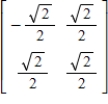 is orthogonal.
is orthogonal.
 is orthogonal.
is orthogonal.
فتح الحزمة
افتح القفل للوصول البطاقات البالغ عددها 32 في هذه المجموعة.
فتح الحزمة
k this deck
21
The matrix  is orthogonal.
is orthogonal.
 is orthogonal.
is orthogonal.
فتح الحزمة
افتح القفل للوصول البطاقات البالغ عددها 32 في هذه المجموعة.
فتح الحزمة
k this deck
22
Find an orthogonal matrix P such that  diagonalizes
diagonalizes  .
.
A)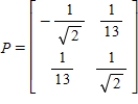
B)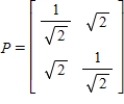
C)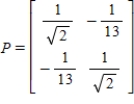
D)
E)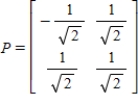
 diagonalizes
diagonalizes  .
.A)

B)

C)

D)

E)


فتح الحزمة
افتح القفل للوصول البطاقات البالغ عددها 32 في هذه المجموعة.
فتح الحزمة
k this deck
23
Find an orthogonal matrix P such that  diagonalizes
diagonalizes  .
.
A)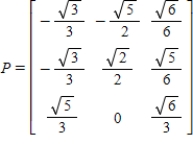
B)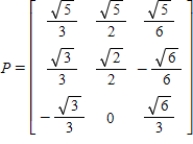
C)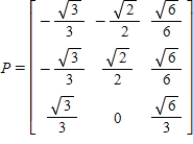
D)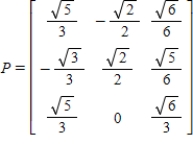
E)
 diagonalizes
diagonalizes  .
.A)

B)

C)

D)

E)


فتح الحزمة
افتح القفل للوصول البطاقات البالغ عددها 32 في هذه المجموعة.
فتح الحزمة
k this deck
24
Use the age transition matrix  and age distribution vector
and age distribution vector  to find the age distribution vectors
to find the age distribution vectors  and
and  .
.
A) and
and 
B) and
and 
C) and
and 
D) and
and 
E) and
and 
 and age distribution vector
and age distribution vector  to find the age distribution vectors
to find the age distribution vectors  and
and  .
.A)
 and
and 
B)
 and
and 
C)
 and
and 
D)
 and
and 
E)
 and
and 

فتح الحزمة
افتح القفل للوصول البطاقات البالغ عددها 32 في هذه المجموعة.
فتح الحزمة
k this deck
25
Find a stable age distribution for the age transition matrix  .
.
A) , where t is any positive number
, where t is any positive number
B) , where t is any positive number
, where t is any positive number
C) , where t is any positive number
, where t is any positive number
D) , where t is any positive number
, where t is any positive number
E) , where t is any positive number
, where t is any positive number
 .
.A)
 , where t is any positive number
, where t is any positive numberB)
 , where t is any positive number
, where t is any positive numberC)
 , where t is any positive number
, where t is any positive numberD)
 , where t is any positive number
, where t is any positive numberE)
 , where t is any positive number
, where t is any positive number
فتح الحزمة
افتح القفل للوصول البطاقات البالغ عددها 32 في هذه المجموعة.
فتح الحزمة
k this deck
26
Find a stable age distribution for the age transition matrix  .
.
A) , where t is any positive number
, where t is any positive number
B) , where t is any positive number
, where t is any positive number
C) , where t is any positive number
, where t is any positive number
D) , where t is any positive number
, where t is any positive number
E) , where t is any positive number
, where t is any positive number
 .
.A)
 , where t is any positive number
, where t is any positive numberB)
 , where t is any positive number
, where t is any positive numberC)
 , where t is any positive number
, where t is any positive numberD)
 , where t is any positive number
, where t is any positive numberE)
 , where t is any positive number
, where t is any positive number
فتح الحزمة
افتح القفل للوصول البطاقات البالغ عددها 32 في هذه المجموعة.
فتح الحزمة
k this deck
27
Suppose a population has the characteristics listed below.
(a) A total of 60% of the population survives its first year. Of that 60%, 50% survives the second year. The maximum life span is 3 years.
(b) The average number of offspring for each member of the population is 4 the first year, 5 the second year, and 4 the third year.The population now consists of 150 members in each of the three age class. How many members will be in each age class after one year? After two years? Let , and
, and  be vectors whose components are the number members in each age class after one year and after two years respectively.
be vectors whose components are the number members in each age class after one year and after two years respectively.
A) and
and 
B) and
and 
C) and
and 
D) and
and 
E) and
and 
(a) A total of 60% of the population survives its first year. Of that 60%, 50% survives the second year. The maximum life span is 3 years.
(b) The average number of offspring for each member of the population is 4 the first year, 5 the second year, and 4 the third year.The population now consists of 150 members in each of the three age class. How many members will be in each age class after one year? After two years? Let
 , and
, and  be vectors whose components are the number members in each age class after one year and after two years respectively.
be vectors whose components are the number members in each age class after one year and after two years respectively.A)
 and
and 
B)
 and
and 
C)
 and
and 
D)
 and
and 
E)
 and
and 

فتح الحزمة
افتح القفل للوصول البطاقات البالغ عددها 32 في هذه المجموعة.
فتح الحزمة
k this deck
28
Solve the system of first-order linear differential equations given below. 
A)
B)
C)
D)
E)

A)

B)

C)

D)

E)


فتح الحزمة
افتح القفل للوصول البطاقات البالغ عددها 32 في هذه المجموعة.
فتح الحزمة
k this deck
29
Solve the system of first-order linear differential equations given below. 
A)
B)
C)
D)
E)

A)

B)

C)

D)

E)


فتح الحزمة
افتح القفل للوصول البطاقات البالغ عددها 32 في هذه المجموعة.
فتح الحزمة
k this deck
30
Find the matrix of the quadratic form associated with the quadratic equation  .
.
A)
B)
C)
D)
E)
 .
.A)

B)

C)

D)

E)


فتح الحزمة
افتح القفل للوصول البطاقات البالغ عددها 32 في هذه المجموعة.
فتح الحزمة
k this deck
31
Use the Principal Axes Theorem to perform a rotation of axes to eliminate the xy-term in the quadratic equation  . Identify the resulting rotated conic and give its equation in the new coordinate system.
. Identify the resulting rotated conic and give its equation in the new coordinate system.
A) Ellipse;
B) Hyperbola;
C) Ellipse;
D) Hyperbola;
E) Ellipse;
 . Identify the resulting rotated conic and give its equation in the new coordinate system.
. Identify the resulting rotated conic and give its equation in the new coordinate system.A) Ellipse;

B) Hyperbola;

C) Ellipse;

D) Hyperbola;

E) Ellipse;


فتح الحزمة
افتح القفل للوصول البطاقات البالغ عددها 32 في هذه المجموعة.
فتح الحزمة
k this deck
32
Use the Principal Axes Theorem to perform a rotation of axes to eliminate the xy-term in the quadratic equation  . Identify the resulting rotated conic and give its equation in the new coordinate system.
. Identify the resulting rotated conic and give its equation in the new coordinate system.
A) Ellipse;
B) Hyperbola;
C) Ellipse;
D) Hyperbola;
E) Ellipse;
 . Identify the resulting rotated conic and give its equation in the new coordinate system.
. Identify the resulting rotated conic and give its equation in the new coordinate system.A) Ellipse;

B) Hyperbola;

C) Ellipse;

D) Hyperbola;

E) Ellipse;


فتح الحزمة
افتح القفل للوصول البطاقات البالغ عددها 32 في هذه المجموعة.
فتح الحزمة
k this deck








